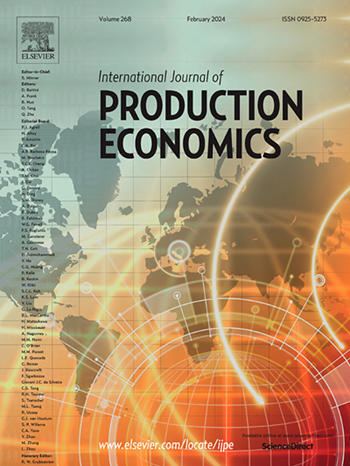Box rates unveiled: Predictive analytics for ocean freight rates with system dynamics and text mining under supply chain disruptions
IF 9.8
1区 工程技术
Q1 ENGINEERING, INDUSTRIAL
引用次数: 0
Abstract
Ocean freight rates are key drivers of supply chain costs, global inflation, trade and economic growth, and their volatile nature, particularly manifest during supply chain disruptions, causes significant supply chain and economic turbulence. This study presents a parameterized system dynamics model to predict the Shanghai Containerized Freight Index (SCFI), incorporating both linear and nonlinear interrelationships among transport supply, demand, market sentiment, and freight rates. The model comprises four integrated components: (1) a transport demand estimator based on past container shipping volumes, Gross Domestic Product (GDP), and the Purchasing Managers' Index (PMI); (2) an actual containership capacity model that considers shipping liners’ strategic and tactical capacity decisions such as blank sailings, slow steaming, round voyage duration and idle fleet capacity, along with fleet variables such as ship delivery and scrapping; (3) a novel Market Sentiment Index (MSI) using lexicon-based text mining of news articles, integrated with PMI to quantify market sentiment; and (4) an SCFI prediction model that captures the bidirectional feedback between these components. Results indicate that our system dynamics model outperforms established methods such as XGBoost and ARIMA. Furthermore, we find that freight rates are sensitive to the balance between supply, demand, and market sentiment. Specifically, an oversupply of capacity and declining demand reduce freight rates, whereas capacity constraints caused by supply chain disruptions increase rates. Sensitivity analysis further demonstrates that strategic capacity adjustments, particularly through blank (cancelled) sailings, can effectively increase freight rates. These insights have important implications for strategic, tactical, and operational decision-making within global supply chains.
箱式运价揭晓:供应链中断下基于系统动态和文本挖掘的海运运价预测分析
海运运价是影响供应链成本、全球通胀、贸易和经济增长的关键因素,其波动性,特别是在供应链中断期间表现出来,会导致严重的供应链和经济动荡。本文建立了一个参数化系统动力学模型,结合运输供给、需求、市场情绪和运价之间的线性和非线性相互关系,对上海集装箱运价指数(SCFI)进行预测。该模型由四个组成部分组成:(1)基于过去集装箱运输量、国内生产总值(GDP)和采购经理指数(PMI)的运输需求估算器;(2)实际集装箱船运力模型,该模型考虑了班轮公司的战略和战术运力决策,如空白航次、慢速航次、往返航次和闲置船队运力,以及船队变量,如船舶交付和报废;(3)利用基于词典的新闻文章文本挖掘,结合PMI构建了新的市场情绪指数(MSI)来量化市场情绪;(4)捕获这些组件之间双向反馈的SCFI预测模型。结果表明,我们的系统动力学模型优于现有的方法,如XGBoost和ARIMA。此外,我们发现运费对供需和市场情绪之间的平衡很敏感。具体来说,运力供过于求和需求下降会降低运费,而供应链中断导致的运力限制会提高运费。敏感性分析进一步表明,战略性运力调整,特别是通过空白(取消)航次,可以有效提高运价。这些见解对全球供应链中的战略、战术和运营决策具有重要意义。
本文章由计算机程序翻译,如有差异,请以英文原文为准。
求助全文
约1分钟内获得全文
求助全文
来源期刊
CiteScore
21.40
自引率
7.50%
发文量
266
审稿时长
52 days
期刊介绍:
The International Journal of Production Economics focuses on the interface between engineering and management. It covers all aspects of manufacturing and process industries, as well as production in general. The journal is interdisciplinary, considering activities throughout the product life cycle and material flow cycle. It aims to disseminate knowledge for improving industrial practice and strengthening the theoretical base for decision making. The journal serves as a forum for exchanging ideas and presenting new developments in theory and application, combining academic standards with practical value for industrial applications.

 求助内容:
求助内容: 应助结果提醒方式:
应助结果提醒方式:


